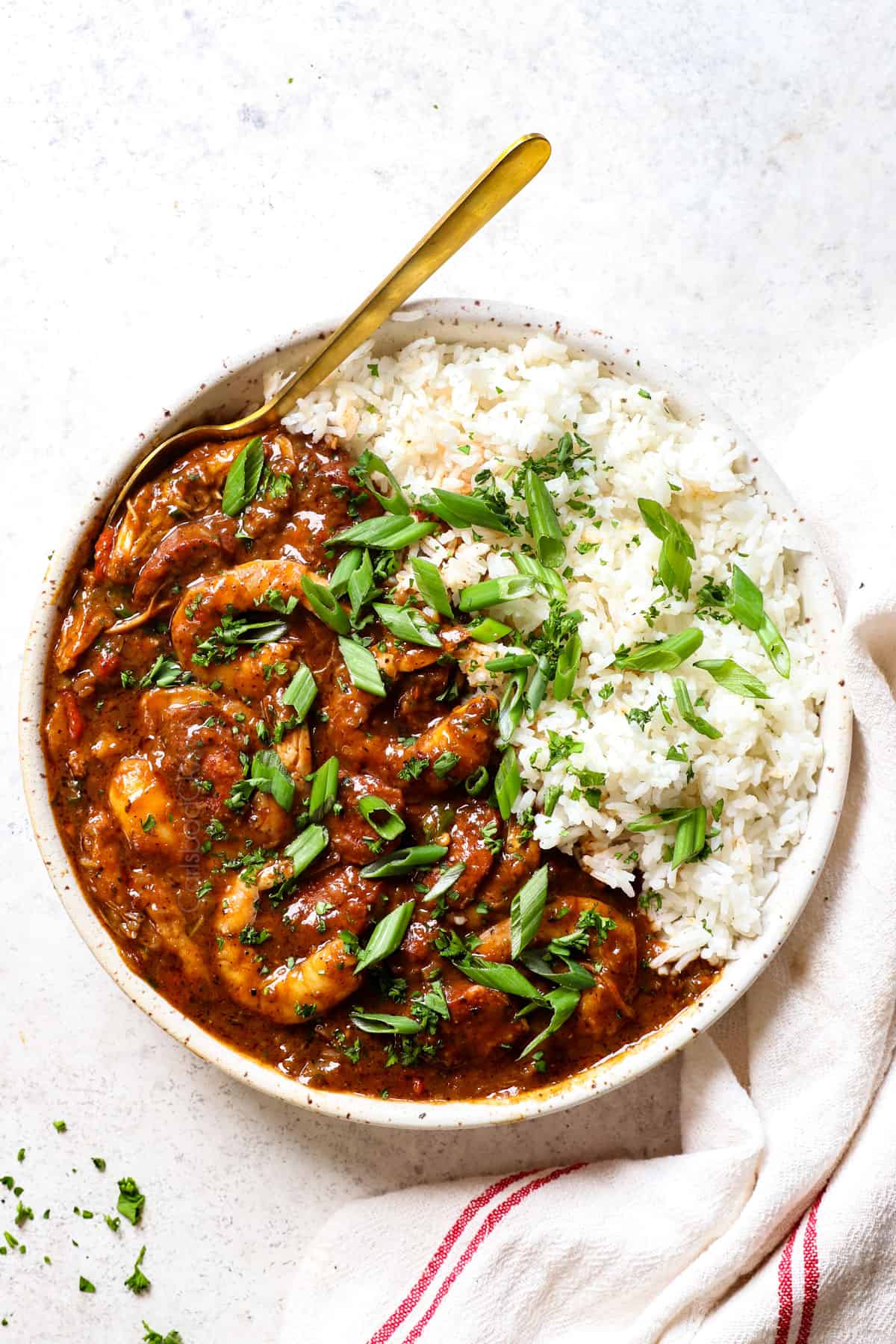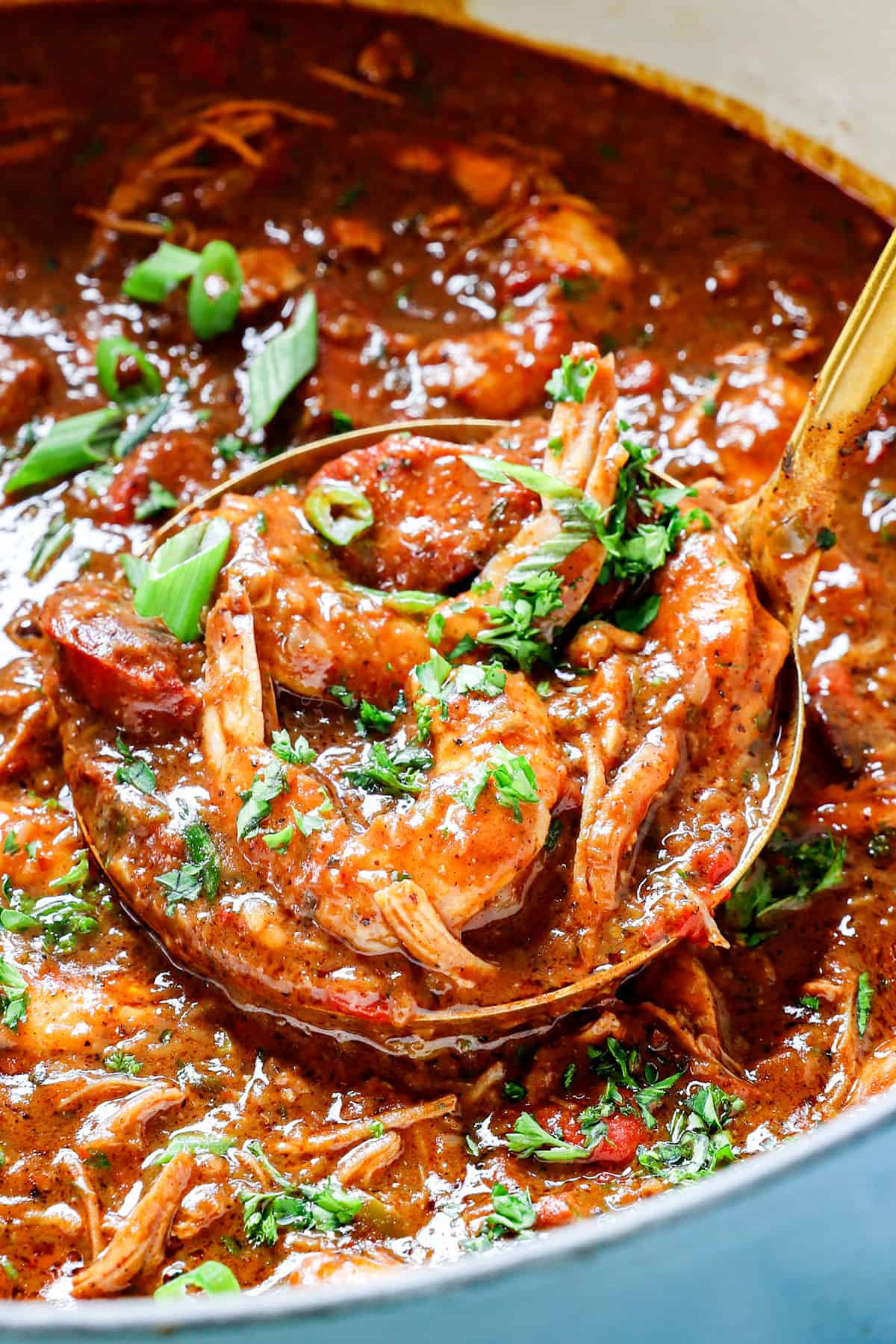Hello, everyone! If you’re looking for “what is chicken gumbo?” you’ve come to the right place. I’m about to tell you all about this hearty Louisiana dish, or stew, Chicken gumbo is a hearty stew made with tender chicken, spicy sausage, and a mix of vegetables cooked in a tasty broth. It is usually served over rice. This dish is a cultural icon and comfort food with a kick. Each spoonful tells a story of family and history. Please bear with me as I explain what makes this pot of goodness so unique.
Chicken Gumbo at Its Core: What’s in the Pot?
Let’s get right to the good stuff. Chicken gumbo is a type of gumbo which is a stew famous in Southern cooking especially around New Orleans. It’s got a base of chicken—usually juicy, tender pieces—that’s cooked slow to soak up all the flavors. But it ain’t just chicken; this dish is a party of ingredients that come together like a jazz band on a Saturday night.
Here’s the lowdown on what typically goes into a pot of chicken gumbo:
- Chicken: The star of the show! Often thighs or legs for that rich, fall-off-the-bone vibe.
- Andouille Sausage: A smoky, spicy sausage that adds a punch. If you can’t find it, any smoked sausage will do in a pinch.
- Okra: This green veggie gives gumbo its signature thickness and a bit of a slimy texture (don’t knock it till ya try it).
- The Holy Trinity: No, not a religious thing, but a mix of onions, bell peppers, and celery. It’s the flavor foundation of most Southern stews.
- Rice: Served on the side or under the stew, it soaks up all that yummylicious broth.
- Roux: A mix of flour and fat (like butter or oil) cooked till it’s dark and toasty. It thickens the stew and adds a nutty depth.
- Spices: Think cayenne, paprika, and sometimes a dash of Creole seasoning for that extra zing.
I remember the first time I threw together a gumbo at home; the smell of that roux browning had my whole house feelin’ like a Louisiana diner. It’s not just food—it’s a whole mood!
| Ingredient | Role in Chicken Gumbo |
|---|---|
| Chicken | Main protein, adds heartiness |
| Andouille Sausage | Brings smoky spice and depth |
| Okra | Thickens the stew, adds unique texture |
| Holy Trinity (Onions, Bell Peppers, Celery) | Flavor base, essential for authenticity |
| Rice | Complements the stew, fills you up |
| Roux | Thickener, gives a rich, nutty undertone |
A Taste of History: Where’d Chicken Gumbo Come From?
Now, let’s dig into the roots of this dish cause chicken gumbo ain’t just a recipe—it’s a story. Gumbo, in general, hails from Louisiana, and it’s like a meltin’ pot of cultures, just like the folks who settled there. Way back in the 18th century, you had African, French, Spanish, and Native American influences all mixin’ up in the bayou. Each group tossed somethin’ into the pot, figuratively and literally.
The word “gumbo” probably comes from African languages and refers to okra, which was brought to the U.S. by Africans who were forced to work as slaves. They knew how to use it to make hearty stews. The French then added their fancy roux method, which involves cooking flour and fat until it’s just right. Native people added filé powder, which is made from ground sassafras leaves and was another way to thicken things up. The Spanish added peppers for flavor. When it comes to chicken gumbo, the Cajun style is more about meats that come from the land, like chicken and sausage. This is different from the Creole style, which is more about seafood.
I think it’s pretty cool how this dish represents the people who made it: a mix of backgrounds coming together to make something greater than the sum of its parts. It makes me think of all the hands that stirred the pot before me when I cook it.
Cajun vs. Creole: What’s the Diff in Chicken Gumbo?
As for styles, you may hear people talk about Cajun and Creole gumbo. Yes, there is a difference. I’ve tried both ways with chicken as the main ingredient, and they each had their own style.
- Cajun Chicken Gumbo: This is the country cousin, rooted in the swamps and rural parts of Louisiana. It’s usually got a dark roux—almost chocolate-brown—and focuses on meats like chicken and sausage. It’s spicier, earthier, and often skips tomatoes. The veggies ain’t strained out; it’s all in there, rustic-like.
- Creole Chicken Gumbo: This one’s the city slicker, born in New Orleans. It might still have chicken, but it’s likely to mix in some seafood too. Creole style often uses tomatoes, makin’ the stew a bit redder, and the roux might not be as dark. It’s got a more refined vibe, if ya ask me.
Both are delish, but if I’m cravin’ pure comfort, I lean Cajun with my chicken gumbo. It’s like a hug in a bowl, ya know?
How Do Ya Make Chicken Gumbo? A Down-Home Guide
Alright, let’s roll up our sleeves and talk cookin’. I ain’t gonna lie—makin’ chicken gumbo takes time, but it’s worth every minute. It’s a slow simmer kinda dish, perfect for a lazy weekend when you just wanna hang in the kitchen with a glass of somethin’ cold. Here’s how I do it, step by step, keepin’ it real simple for y’all.
- Start with the Roux: Grab a big pot or Dutch oven. Mix equal parts oil (or butter) and flour—say, half a cup each. Cook it over medium heat, stirrin’ constantly so it don’t burn. You want it dark, like a deep caramel or even chocolate shade. This takes patience, maybe 20-30 minutes. If it smells nutty, you’re on track.
- Add the Holy Trinity: Toss in chopped onions, bell peppers, and celery. I use about a cup of each. Let ‘em soften up in that roux for 5-10 minutes till they smell amazing.
- Throw in the Meat: Add your chicken pieces—thighs work best, bout 2 pounds worth. Brown ‘em a bit, then slice up some Andouille sausage, maybe a pound, and chuck that in too.
- Season and Simmer: Sprinkle in salt, pepper, cayenne, and a bay leaf or two. Pour in about 6-8 cups of chicken stock or water. Bring it to a boil, then lower the heat to a simmer. Let it go for at least 2-3 hours. The longer, the better—flavors gotta meld!
- Add Okra: Bout 30 minutes before you’re done, toss in sliced okra, maybe 2 cups. It’ll thicken things up nice. If okra ain’t your jam, skip it, though it won’t be quite the same.
- Serve It Up: Spoon it over hot rice. Some folks like to sprinkle filé powder on top right before eatin’ for extra thickness and a sassafras kick.
Pro tip: Don’t rush the roux. I burnt mine once and the whole batch tasted like regret. Stir slow and steady, and you’ll be golden.
Why Chicken Gumbo Matters: More Than Just a Meal
Here’s the thing—chicken gumbo ain’t just food. Down in Louisiana, it’s a way of life. I’ve heard tales of big family gatherings where a giant pot of gumbo feeds everyone from granny to the neighbor’s kid. It’s the go-to for celebrations, like Mardi Gras, where folks even go door-to-door beggin’ for ingredients to make a communal batch. How cool is that?
It’s also super practical. Back in the day, gumbo was a way to use up whatever you had—leftover chicken, a bit of sausage, some veggies about to go bad. With a big enough pot, you can double or triple the recipe to feed a crowd without breakin’ the bank. I love that vibe—makin’ somethin’ amazing outta humble stuff.
And lemme tell ya, it’s a dish that crosses all kinda lines. No matter who you are, where you’re from, if you sit down to a bowl of chicken gumbo, you’re part of the family for that meal. It’s got this magic way of bringin’ folks together, kinda like a warm campfire on a chilly night.
Variations on Chicken Gumbo: Mixin’ It Up
Now, don’t think chicken gumbo is set in stone. Every cook’s got their twist, and that’s the beauty of it. I’ve played around with mine plenty, and here are some ideas I’ve picked up or tried myself.
- Add Some Heat: If you like it fiery, toss in extra cayenne or a splash of hot sauce at the end. My buddy swears by a few dashes of Tabasco, and I ain’t mad at it.
- Switch the Protein: Sure, it’s chicken gumbo, but sometimes I sneak in shrimp or crab near the end of cookin’ for a surf-and-turf feel. Just don’t overcook the seafood.
- No Okra? No Prob: Some folks ain’t fans of okra’s texture. You can rely on roux alone to thicken, or even use filé powder instead. I’ve done it both ways, depends on my mood.
- Side Dish Vibes: Most serve it with rice, but I’ve had it over potato salad once at a friend’s place. Sounds weird, but it works—kinda creamy and cool against the spicy stew.
There’s a gazillion ways to make it your own. Experiment, mess up, laugh about it, and try again. That’s how ya learn to cook with soul.
Tips for the Best Dang Chicken Gumbo
Before I let ya go, here’s a few nuggets of wisdom I’ve gathered from my gumbo adventures. These’ll help ya avoid common pitfalls and make a pot that’ll have folks beggin’ for seconds.
- Take Your Time: Gumbo ain’t fast food. Let it simmer for hours if you can. The flavors deepen like a good friendship.
- Taste as Ya Go: Don’t be shy—grab a spoon and check the seasoning. Add a pinch more salt or spice if it’s lackin’. I forgot to taste once and ended up with a bland mess.
- Store It Right: Got leftovers? Freeze ‘em within a couple hours so it don’t go stringy, especially if you used filé powder. Reheats like a dream.
- Big Pot, Big Love: Use the biggest pot ya got. Gumbo’s meant for sharing, so make enough to go around. My old pot barely holds enough, and I always regret not scalin’ up.
Wrappin’ Up: Why You Gotta Try Chicken Gumbo
So, what is chicken gumbo? It’s a Southern stew packed with chicken, sausage, okra, and a whole lotta heart. It’s a dish born from a clash of cultures—African, French, Native, and more—that somehow sings in perfect harmony. Whether you’re goin’ Cajun with a dark roux and spicy kick or Creole with a tomato twist, it’s all about slow-cooked comfort that sticks to your ribs.
I urge ya to give it a shot in your own kitchen. Yeah, it takes time, but so does anything worth doin’. Grab some chicken, fire up that stove, and let the magic happen. And hey, if you got your own gumbo stories or tricks, drop ‘em in the comments. I’m always down to learn a new twist on this classic. Let’s keep the pot stirrin’ and the good vibes flowin’!
:max_bytes(150000):strip_icc()/classic-chicken-gumbo-3053205-hero-01-364dce39b9be472b92e1ed70daf789cd.jpg)
how do I prep gumbo ahead of time?
You can prepare the entire chicken and sausage gumbo recipe as written and reheat leftovers throughout the week, or you can prepare elements of the recipe in advance, or up to any stage of the recipe:-Aromatics: the veggies can be chopped and stored in an airtight container for up to 3 days in the fridge. -Spices: can be measured and stored in a sealable plastic bag until ready to use. -Chicken: can be trimmed OR trimmed, seasoned, and kept in the fridge for up to two days in a single layer in a container that won’t let air in. You can also proceed to sear the chicken, storing the pan and drippings in the fridge. -Sausage: can be cut up and kept in an airtight container for two days, or sear it after the chicken and put the pan and any juices in the fridge. -Roux: can be made completely ahead of time, then add the broth, (so the roux doesn’t continue to cook), seasonings and chicken back to the pot, cool to room temperature and refrigerate. To save time, you can make the gumbo up to the point where you add the shrimp and then chill and put it in the fridge for one or two days. Bring to a simmer, remove from heat, then proceed to add the shrimp, file, green onions and parsley. -Rice: Can be cooked up to three days in advance. Store in the fridge in an airtight container.
- Coleslaw: The sour, sweet, cold, crunchy, and creamy coleslaw goes well with the nutty heat.
- Potato salad: Another cold option is potato salad, which is creamy and cold.
- Wedge salad, garden salad, and apple salad are all great fresh sides for the hearty stew.
- There are two kinds of cornbread: sweet cornbread and cornbread blueberry muffins. Both are very moist, tender, and very sweet.
- Hushpuppies are a delicious side dish or appetizer because they are golden and crispy on the outside and soft on the inside from cornbread.
- Prep ingredients first. Use a food processor to chop the vegetables. Season the chicken and sausage and have chicken broth ready. Now, you’re ready to add the ingredients as needed. You should have the chicken broth on hand so that you can add it right away to the roux and keep it from burning.
- Don’t skip searing the chicken. The Maillard reaction happens when amino acids and reducing sugars make the chicken brown. As we all know, color = flavor! The tasty brown bits left in the bottom of the pan will season the whole gumbo as they seep into the roux.
- Don’t burn drippings. Make sure the heat isn’t too high as you sear the chicken until it turns golden. Black drips will make the stew taste burnt, so don’t use them. Lower the heat if the chicken is browning too quickly.
- Don’t overcook the chicken. Just until the chicken is easy to shred with two forks, cook it in the stew. This could take longer or shorter time depending on the chicken’s size, the pot, the simmering strength, and other factors. The chicken thighs may be done at different times, so you may need to take them out of the pot at different times. If your chicken isn’t tender, cook on!.
- Cook the roux until dark brown. The gumbo tastes best when it’s made with a dark brown roux. Don’t just use chocolate; use dark chocolate instead. It will have stronger, bigger, nuttier flavors than just chocolate roux. When the roux turns chocolate brown, I suggest lowering the heat to medium-low and continuing to cook so you don’t burn it by accident. You’re done when the roux turns a deep brown color and smells great, like nuts.
- Don’t burn the roux. Since the roux will taste burned if it gets burned, it’s best to throw it out and start over. To avoid this, keep whisking the roux, lower the heat as needed, and add more oil if the flour starts to stick to the pan at any point.
- Add the shrimp off the heat. If you want to use shrimp in this recipe, put it in the pot after the heat is off. The shrimp will cook in the residual heat. This method always makes shrimp that are perfectly cooked, plump, juicy, and never rubbery.
- Don’t cook the gumbo filé. If you add the filé powder while it’s not hot, it will turn stringy and bitter if it stir-fries.
- Control the consistency. Some people like their gumbo thick like a stew, but you can make it soupier by adding more broth. Also, you can change the consistency by letting the pot simmer with or without the lid for the last 15 minutes after adding the chicken shreds. It will be thicker if you leave the lid off, but it will be brothier if you leave the lid on.
- Add heat to taste. Whether you like your gumbo mild or spicy, we like ours spicy! If you’re not sure how spicy you want it, add more cayenne pepper at the end of cooking. It’s easy to add heat, but tough to take it away!

- Add any kind of protein to your gumbo. You can use shrimp, lump crab meat, oysters, sausage, chicken, duck, or even boiled eggs. You can use one type of protein or a mix of them.
- Use rotisserie chicken: Instead of chicken thighs, use about 3 cups of crushed rotisserie chicken. As the gumbo recipe says, add the shredded chicken back to the pot. Instead, add the chicken to the stew.
- You can add more vegetables. Gumbo is always made with the holy trinity of vegetables, but you can add more (even if they’re not authentic). Most vegetables don’t need to simmer for a long time, and they can be added with the chicken shreds.
- Make it spicier by adding more cayenne and/or hot sauce to your liking, or jalapenos, Scotch bonnets, serrano peppers, habaneros, and other peppers.
- Vegetarian gumbo: Use any vegetables you like instead of the meat, like potatoes, carrots, mushrooms, cauliflower, etc. Alternatively, use your favorite meat substitute.
- Make it gluten-free: You can use gluten-free flour instead of regular flour. Also, make sure your sausage is gluten-free. For a different texture, you can leave out the flour and add okra instead.
- If you want, you can serve it over low-carb cauliflower rice, broccoli rice, quinoa, or even spaghetti squash.


Store leftover chicken, sausage and shrimp gumbo in an airtight container in the fridge for up to four days.

This gumbo recipe is a soul-satisfying taste of New Orleans, loaded with juicy chicken, smoky Andouille sausage, plump shrimp and bold spices – it’s one for the recipe binder!
This chicken sausage gumbo is one of the most flavorful, satisfying meals you’ll ever devour; the kind of hot, steaming spoonful that makes your eyes roll back in your head in awe. So, if you’ve never made this New Orleans classic before, NOW is the time – it’s easier and 1000x better than you might think! This recipe boasts a deeply flavorful, dark chocolate colored roux, the holy trinity of onions, bell peppers and celery, protein in the form of juicy chicken, andouille sausage and optional shrimp, all boldly seasoned with a homemade paprika, cayenne, thyme spice mix for zippy, smoky, nutty heat. Serve your chicken gumbo over a big bowl of rice for one of life’s most dizzying delicious pleasures.
How to Make Chicken & Sausage Gumbo | Allrecipes
FAQ
What does chicken gumbo have in it?
Ingredients2 medium onions. 1 green bell pepper. 3 ribs celery. 3 tablespoons vegetable shortening (or oil)3 tablespoons all-purpose flour. 4 cups chicken stock (unsalted or low sodium)1 (14 1/2-ounce) can diced tomatoes (with juice)1 1/2 cups sliced okra, fresh or frozen.
What does gumbo taste like?
Gumbo has a rich, savory flavor profile, characterized by a dark, toasty roux base, the aromatic “holy trinity” of onions, bell peppers, and celery, and the flavors of the chosen protein (like seafood or chicken and sausage).
What makes a gumbo?
Gumbo is a hearty stew, characterized by a flavorful stock, a mix of meats or seafood (or both), and a thickener, often including the “holy trinity” of vegetables: celery, bell peppers, and onions.
What’s the difference between soup and gumbo?
Contrarily, a soup is a liquid that can have stuff added to it. I think gumbo is basically the liquid that has the trinity, okra, and roux melted into it. Then different proteins like seafood, chicken, duck, and sausage are added to it, making it a soup.
